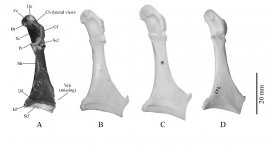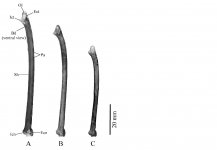Juan Miguel Ramírez-Castroa & Víctor Hugo Reynoso, 2021
NEW BIRD RECORDS FOR THE LATE PLEISTOCENE OF THE
AMERICAN CONTINENT RECOVERED IN CENTRAL MÉXICO AND
THEIR PALEOGEOGRAPHIC IMPLICATIONS
ournal of South American Earth Sciences (advance online publication)
doi: 10.1016/j.jsames.2021.103578
SYSTEMATIC PALEONTOLOGY
Aves Linaeus, 1758
Anseriformes Wagler, 1831
Anatidae Vigors, 1825
Tadornini Reichenbach, 1850
Material. A left coracoid (MPG-R-10134) and a right coracoid (MPG-R-10153)
Description. The coracoids have a total length of ca. 47.5 and ca. 48.5 mm respectively and lack the sterno-coracoidal process. In ventral view, the head is rounded, the brachial tuberosity is strongly projected medially with respect to the shaft, the neck is moderately elongated and thin, and the internal distal angle is slightly blunt and thick dorsoventrally. In dorsal view, the furcular facet is slightly flattened medially with respect to the shaft and is dorsoventrally wide; its surface has a depression ventral to the brachial tuberosity and is undercut at its posterior border near the brachial tuberosity, the triosseal canal is deep and extensive, the glenoid facet is long and in lateral position, the scapular facet is concave, deep and with a rounded triangular shape, the procoracoid is well developed, the sternal facet is concave, wide and with a rectangular shape along the posterior margin of the element with a not very prominent dorsal lip, the angle between the sternal facet and shaft is 81 in MPG-R-10134 and 77 and MPG-R-10153. In anterolateral view, the coraco-humeral surface is deep, and its thickness is uniform throughout its entire anterior margin.
Taxonomic assessment. Both coracoids are similar in shape to Tadorna and about the size of a female Tadorna cana, a male Tadorna tadorna, a male Anas acuta and Lophonetta specularioides. The degree of ossification of the fossils indicates that both coracoids were from adult animals (Emslie, 1985). The fossils were assigned to Tadonini, and differentiated from other Anatinae (Woolfenden, 1961 character numbers in brackets) on the relatively larger procoracoid compared to other ducks [character 1], the deeper triosseal canal compared to other ducks [character 2], the depression ventral to the brachial tuberosity on the surface of the furcular facet [character 3], the extensively undercut near the brachial tuberosity of the furcular facet [character 4], the angle between the sternal facet and the shaft within the range of 75.5 to 81 [character 5], and the blunt and dorsoventrally thick internal distal angle (Howard, 1964). Although establishing the generic position of the fossil coracoids is difficult, the entire furcular facet with a relatively small depression and undercutting, and the lack of pneumatic foramina under the furcular facet (characters 1 and 2 of Woolfenden, 1961, respectively), strongly suggest that the coracoids are similar to those of Tadorna. Curiously, in MPG-R-10134 characters 1 and 4 of Woolfenden (1961) are more similar to the Anatini (specially Anas) than Tadornini, possibly caused by wear during the fossilization process, but the remaining characters strongly support it as a Tadornini. The specimens agree with Anabernicula, a common extinct genus of the Neogene and Quaternary of North America, in their similar rounded and heavy triosseal canal, and the anterior end of the coracoid facing slightly posteriorly (Howard, 1964). According to the series of characteristics referred by Steadman and Mead (2010) that allow the differentiation the coracoid of the tadornine Anabernicula from that of the duck Anas; the coracoids from Chapala-Zacoalco have a deep coraco-humeral surface, similar to that referred by Steadman and Carranza-Castañeda (2006) to identify a fossil coracoid as cf. Tadornini of the early Blancan (Late Pliocene) from Guanajuato, México. The fossils have a number of features and general shape similar to the extant Tadorna and are similar in size to a female Tadorna cana, tough their size also agrees with certain species of Anabernicula. The medial length of the fossils of 43.47 and 44.41 mm respectively approximates well to that of Anabernicula gracilenta from the Late Pleistocene of Rancho La Brea, Los Angeles, USA, with an average of 45.5 mm; and that of A. oregonensis from Fossil Lake, Oregon, USA (Late Pleistocene), with an average of 48.3 mm (Howard, 1964). Furthermore, the length of the fossils of ca. 47.5 and ca. 48.5 mm respectively approximates to that of a specimen of Anabernicula cf. A. oregonensis from Térapa, Sonora, México (Rancholabrean, Late Pleistocene), with a total length of 46.1 mm (Steadman and Mead, 2010), and that of a coracoid of the same species from the early Blancan (Late Pliocene) from Guanajuato, México, with a total length of 47.4 mm (Steadman and Carranza-Castañeda, 2006; Steadman and Mead, 2010). However, the Chapala-Zacoalco coracoids differ from Anabernicula in that their furcular facet overhangs more medially than in this genus, the procoracoid is more curved especially toward its medial end (as in Tadorna), and in that the depression of the triosseal canal is more extensive (as in Tadorna) (Howard, 1964). Additionally, the total length of the fossils and the width of the basal articular face (or length of the sternal facet) of ca. 17 and ca. 18 mm respectively agrees with the extant anatid Lophonetta specularioides (45.4-51.0 mm in total length, and 17.7-20.3 mm for the width of the basal articular face, n = 3) (Campbell, 1979). However, Woolfenden (1961) and Campbell (1979) do not describe thoroughly the coracoid of Lophonetta making it impossible to compare. Today, the distribution of L. specularioides is restricted to South America (Bulgarella, 2020). The coracoids were assigned to an indeterminate Tadornini because they have a unique combination of characters and size that make their identification difficult, suggesting they can belong to a new species.
Coraciiformes Forbes, 1884
Alcedinidae Rafinesque, 1815
Cerylinae Reichenbach, 1851
Megaceryle Kaup, 1848
Megaceryle torquata Linnaeus, 1766
Material. A left ulna (MPG-R-10195
Description. The ulna has a total length of 80.65 mm. In dorsal view, the olecranon is high and pointed, the shaft is practically straight, curving towards the first third of its total length from the proximal end, the papillae are faintly developed, the external condyle is large and rounded, extending laterally, and both condyles are extended almost at the same level. In medial view, the external cotyle is projected dorsally and is hooked, and the internal cotyle is rounded at its ventral edge. In ventral view, the brachial depression is well excavated.
Fred
Figure 1. Coracoid of ducks in dorsal view. A, Tadornini, fossil, MPG-R-10153. B, Tadorna cana, modern specimen, USNM 500289. C, Tadorna tadorna, modern specimen, USNM 432290. D, Anas acuta, modern specimen, CNAV e002879. He = head, Fc = furcular facet, Bt = brachial tuberosity, Tc = triosseal canal, Pr = procoracoid, Ch = coraco-humeral surface, Gf = glenoid facet, Scf = scapular facet, Sh = shaft or neck, Id = internal distal angle, Stf = sternal facet, Dl = dorsal lip, Scp = sterno-coracoidal process.
Figure 2. Left ulna of kingfishers in dorsal view. A, Megaceryle torquata, fossil, MPG-R- 10195. B, Megaceryle torquata, modern specimen, INAH 5128. C, Megaceryle alcyon, modern specimen, INAH 5129. Ol = olecranon, Ict = internal cotyle, Ect = external cotyle, Bd = braquial depression, Pa = papillae, Sh = shaft, Icn = internal condyle, Ecn = external condyle.






